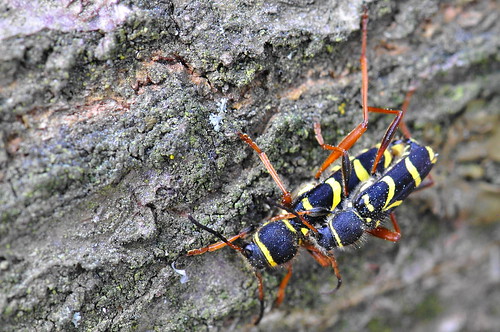 |
| The Wasp Beetle Clytus arietus Sherwood Forest Nottinghamshire |
One of the main intentions of this blog is to try to get people to go out and have a look for some of the beetles that I have found in Nottinghamshire. It's aimed at those naturalists who generally know their birds, have a good idea of what butterfly they're looking at and probably take notice of most things that fly and buzz past them in the summer but can't put a species name to them. So where to start with beetles, I'd probably say showy ones that like sitting on flowers, the majority of which can be identified using a photograph. Therefore my first few beetle blogs have concentrated on Longhorn beetles of the family Cerambycidae. About 60 species of the worlds 20,000 odd species can be considered British. Of these I would say that approximately 20 occur in Nottinghamshire, I say approximately as species are found new to the county, some rare species may no longer be in the county. These range in size from the conspicuous Musk Beetle (Aromia moschata) average size about 30mm to the inconspicuous Plum beetle, Tetrops praeustus at around 4-5mm. Most have the characteristic Long antenna that give them their distinctive look and most visit flowers at some time of their brief lives. The table below lists the species I have so far encountered in Nottinghamshire together with when and where the best place in the county is to see them. I will in the near future be adding more detailed notes on several of the species listed below. I would also be interested in receiving information on other sites for these species and if you are aware of other species being found in the county. Apologies for lack of Common names, they don't exist for many and in all honesty, if you get into beetles you don't need them or use them. Illustrated identification guides were published in British Wildlife Magazine August and October 2007 editions, these may still be available from the publishers.
| Latin Name | Best Months to find | Where to find | Visits Flowers |
| Rhagium bifasciatum | April/May | Pine Woods Sherwood Forest | |
| Rhagium mordax | April/May | Pine woods, North Notts. | |
| Stenocorus meridianus | June | Ash Woods Along the Trent, Treswell Wood | Yes |
| Grammoptera ruficornis | April/May | Almost ubiquitous - on Hawthorn blossom | Yes |
| Leptura quadrifasciata | June/July | Trent Valley, Holme Pierrepont, Shelford, Sherwood F. | Yes |
| Paracorymbia fulva | July | Toton Sidings (Notts Derbys border) | Yes |
| Rutpela maculata | June/July | Sherwood Forest, infrequent in trent Vally woods. | Yes |
| Stenurella melanura | | Not sure where, found one on dog daisy in Carlton Notts. | Yes |
| Asemum striatum | April/May | Pine Woods Sherwood Forest, early morning on logs | |
| Arhopalus rusticus | August/September | At Moth trap lights Sherwood Forest | |
| Aromia moschata | July/August | Trent Valley, Holme Pierrepont, Attenborough NR. | Yes |
| Pyrrhidium sanguineum | April | ? | |
| Phymatodes testaceus | July | Sherwood Forest, Difficult - it's nocturnal | |
| Poecilium alni | May | On freshly cut Oak, Sherwood Forest | |
| Clytus arietus | May/June | Common, Easily seen at Sherwood Forest on cut Oak | Yes |
| Anaglyptus mysticus | May/June | Hawthorn Blossom Trent Valley | Yes |
| Agapanthia villosoviridescens | June | On Hogweed or thistle stems - Holme Pierrepont | Yes |
| Leiopus nebulosus | June/July | Sherwood Forest. | |
| Saperda scalaris | June | On Logs Sherwood Forest. Quite Scarce so difficult to find | |
| Stenostola dubia | | Wellow Wood (I have not seen this one) | |
| Phytoeica cylindrica | April/May | Stems Cow Parsley, Trent Valley Along River Shelford | Yes |
| Tetrops praeustus | May/June | Hawthorn Bloosom, Shelford, Holme Pierrepont | Yes |

No comments:
Post a Comment